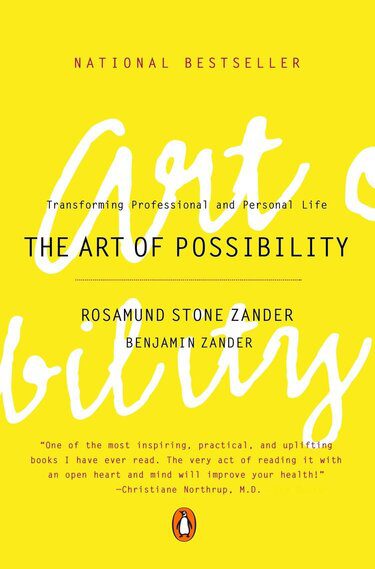In “The Art of Possibility: Transforming Professional and Personal Life“, musical director of the Boston Philharmonic Orchestra Benjamin Zander and psychotherapist Rosamund Stone Zander presents twelve practices for bringing creativity and a sense of possibility into our professional and personal lives.
Books Premise
Many of the circumstances that seem to block us in our daily lives may only appear to do so based on a framework of assumptions we carry with us. Draw a different frame around the same set of circumstances and new pathways come into view. Find the right framework and extraordinary accomplishment becomes an everyday experience.
Book Theme
It is a book with suggestions for novel ways of defining ourselves, others, and the world we live in—ways that may be more apt for the challenges of our time. It uses the metaphor of music, and relies on all the arts. Art, after all, is about rearranging us, creating surprising juxtapositions, emotional openings, startling presences, flight paths to the eternal.
The First Practice: It’s All Invented
The senses of every species are fine-tuned to perceive information critical to their survival—dogs hear sounds above our range of hearing, insects pick up molecular traces emitted from potential mates acres away. We perceive only the sensations we are programmed to receive, and our awareness is further restricted by the fact that we recognize only those for which we have mental maps or categories.
The meanings our minds construct may be widely shared and sustaining for us, but they may have little to do with the world itself.
The frames our minds create define—and confine—what we perceive to be possible. Every problem, every dilemma, every dead end we find ourselves facing in life, only appears unsolvable inside a particular frame or point of view. Enlarge the box, or create another frame around the data, and problems vanish, while new opportunities appear.
SECOND PRACTICE: Stepping into a universe of possibility
The World of Measurement vs Universe of Possibility
On the whole, you are more likely to extend your business and have a fulfilled life if you have the attitude that there are always new customers out there waiting to be enrolled rather than that money, customers, and ideas are in short supply. You are more likely to be successful, overall, if you participate joyfully with projects and goals and do not think your life depends on achieving the mark because then you will be better able to connect to people all around you.
On the whole, resources are likely to come to you in greater abundance when you are generous and inclusive and engage people in your passion for life. There aren’t any guarantees, of course. When you are oriented to abundance, you care less about being in control, and you take more risks. You may give away short-term profits in pursuit of a bigger dream; you may take a long view without being able to predict the outcome. In the measurement world, you set a goal and strive for it. In the universe of possibility, you set the context and let life unfold.
The Third Practice: Giving an A
It is an enlivening way of approaching people that promises to transform you as well as them. It is a shift in attitude that makes it possible for you to speak freely about your own thoughts and feelings while, at the same time, you support others to be all they dream of being. The practice of giving an A transports your relationships from the world of measurement into the universe of possibility.
THE PRACTICE OF giving the A both invents and recognizes a universal desire in people to contribute to others, no matter how many barriers there are to its expression. We can choose to validate the apathy of a boss, a player, or a high school student and become resigned ourselves, or we can choose to honor in them an unfulfilled yearning to make a difference.
Fourth Practice: Being a Contribution
The drive to be successful and the fear of failure are, like the head and tail of a coin, inseparably linked. They goaded me on to unusual efforts and caused me, and those around me, considerable suffering. Of course, the surprising thing was that my increasing success did little to lessen the tension.
WHEN YOU PLAY the contribution game, it is never a single individual who is transformed. Transformation overrides the divisions of identity and possession that are the architecture of the measurement model, recasting the tight pattern of scarcity into a widespread array of abundance.
FIFTH Practice: Leading from any chair
A leader does not need a podium; she can be sitting quietly on the edge of any chair, listening passionately and with commitment, fully prepared to take up the baton.
Practice 6: Rule Number 6
Humor and laughter are perhaps the best way we can “get over ourselves.” Humor can bring us together around our inescapable foibles, confusions, and miscommunications, and especially over the ways in which we find ourselves acting entitled and demanding, or putting other people down, or flying at each other’s throats.
Ladder and Downward Spiral
The ladder refers to the worldview that life is about making progress, striving for success, and positioning oneself in the hierarchy. The downward spiral represents, among other things, the slippage that occurs when we try to control people and circumstances to give ourselves a boost.
Downward spiral talk is based on the fear that we will be stopped in our tracks and fall short in the race, and it is wholly reactive to circumstances, circumstances that appear to be wrong, problematic, and in need of fixing.
The Seventh Practice: The way things are
Being present to the way things are is not the same as accepting things as they are in the resigned way of the cow. It doesn’t mean you should drown out your negative feelings or pretend you like what you really can’t stand. It doesn’t mean you should work to achieve some “higher plane of existence” so you can “transcend negativity.” It simply means, being present without resistance: being present to what is happening and present to your reactions, no matter how intense.
The Eighth Practice: Giving way to passion
The world comes to us sorted into parts: people are distinct entities, shapes have edges, and apples and oranges cannot be compared. Rarely do we come upon or experience this integrative energy, and sometimes only serendipitously, like Alice falling through the rabbit hole. This kind of vibrancy may take us by surprise when we find ourselves committing to doing something extraordinary or when we meet each other on a most personal, elemental level. Yet our minds and bodies are perfectly capable of actively surrendering our boundaries and suspending an edge once we know how and where the lines are drawn.
Giving way to passion, has two steps:
1. The first step is to notice where you are holding back, and let go. Release those barriers of self that keep you separate and in control, and let the vital energy of passion surge through you, connecting you to all beyond.
2. The second step is to participate wholly. Allow yourself to be a channel to shape the stream of passion into a new expression for the world.
The Ninth Practice: Lighting a Spark
Enrolling is not about forcing, cajoling, tricking, bargaining, pressuring, or guilt-tripping someone into doing something your way. Enrollment is the art and practice of generating a spark of possibility for others to share.
The practice of enrollment is about giving yourself as a possibility to others and being ready, in turn, to catch their spark. It is about playing together as partners in a field of light. And the steps to the practice are:
1. Imagine that people are an invitation for enrollment.
2. Stand ready to participate, willing to be moved and inspired.
3. Offer that which lights you up.
4. Have no doubt that others are eager to catch the spark.
Practice 10: Being the board
The purpose of naming yourself as the board, or as the context in which life occurs to you, is to give yourself the power to transform your experience of any unwanted condition into one with which you care to live. We said your experience, not the condition itself. But of course once you do transform your experience and see things differently, other changes occur.
When you identify yourself as a single chess piece—and by analogy, as an individual in a particular role—you can only react to, complain about, or resist the moves that interrupted your plans. But if you name yourself as the board itself you can turn all your attention to what you want to see happen, with none paid to what you need to win or fight or fix.
The Eleventh Principle: Creating Frameworks for Possibility
In the realm of possibility, there is no division between ideas and action, mind and body, dream and reality. Leaders who become their vision often seem uncommonly brave to the rest of us. Whether from the middle of the action, or from the sidelines, they are a conduit for carrying the vision forward.
The steps to the practice of framing possibility are:
1. Make a new distinction in the realm of possibility: one that is a powerful substitute for the current framework of meaning that is generating the downward spiral.
2. Enter the territory. Embody the new distinction in such a way that it becomes the framework for life around you.
3. Keep distinguishing what is “on the track” and what is “off the track” of your framework for possibility.
The Twelfth Practice: Telling the WE Story
The WE story defines a human being in a specific way: It says we are our central selves seeking to contribute, naturally engaged, forever in a dance with each other. It points to relationship rather than to individuals, to communication patterns, gestures, and movement rather than to discrete objects and identities. It attests to the in-between.
The steps to the WE practice are these:
1. Tell the WE story—the story of the unseen threads that connect us all, the story of possibility.
2. Listen and look for the emerging entity.
3. Ask: “What do WE want to have happen here? What’s best for US?”—all of each of us, and all of all of us. What’s OUR next step?
The practice of the WE offers an approach to conflict based on a different premise. It assumes there are no fixed wants nor static desires, while everything each of us thinks and feels has a place in the dialogue.
All the Best in your quest to get Better. Don’t Settle: Live with Passion.



Comments are closed.